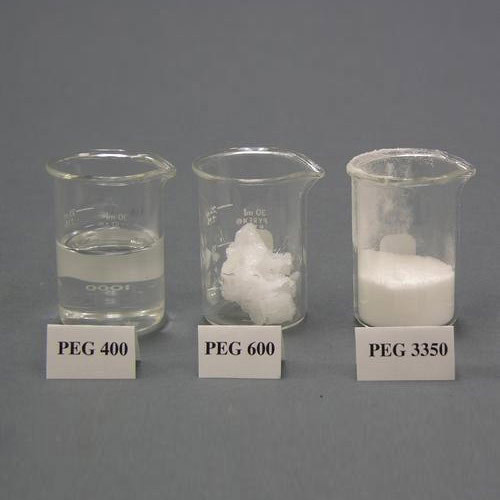Polyethylene Glycol (PEG) Definition
Polyethylene glycol is a highly biocompatible poly (ether), which is soluble in aqueous solutions and organic solvents, which contributes to its biocompatibility and processability, respectively. The low toxicity and non-immunogenicity of poly (ethylene glycol), coupled with the ability for low molecular weight poly (ethylene glycol) s to obtain renal clearance render the biopolymer a popular choice for the surface modification of biomaterials, particles and micelles for active molecule transport, and for chemical and physical hydrogels. Poly (ethylene glycol) is not hydrolytically dissociated in vivo; however, its hydrophilic functionalities confer an enhanced water affinity and biodegradability to the polymer. Poly (ethylene glycol) s are fabricated via the polycondensation of ethylene glycol in the presence of acidic or basic catalysts, producing a lower molecular weight product.
Iran is a big producer of PEG and Hue Jie Oil has a big share on this Production.

Detalis
About Polyethylene Glycol (PEG)
Applications
1. Medical Uses of PEGs
The characteristics of PEGs make them excellent materials for use in the pharmaceutical industry. PEGs are used as lubricants and are employed in a variety of pharmaceutical products as solvents, dispensing agents, ointments, delivery liquids for medications, fillers for tablets, as suppository bases, in ophthalmic solutions and as a treatment for constipation. PEGs are also used in veterinary products.
2. Industrial Uses of PEGS
In manufacturing processes, PEGS are used as water-based coatings, anti-dusting agents in agricultural products, brighteners in electroplating, cleaners and detergents, moisturizers in cosmetic products, dye carriers for paints and inks, packaging products, non-stick agents for molded products, color stabilizers for paper, ceramics manufacture, a softener and anti-static agent in textile manufacture and in soldering fluxes.
3. Oral Health Uses of PEGs
PEGs, in combination with other products, are used in toothpastes, breath fresheners and mouthwashes, including anti-plaque and antiseptic mouth rinses. PEGs are used to keep all ingredients in solution and to increase the shelf-life and stability of the products.
4. Chemical Uses Of PEGs
Because PEG is hydrophilic molecule, it has been used to passivate microscope glass slides for avoiding non-specific sticking of proteins in single-molecule fluorescence studies.
Polyethylene glycol has a low toxicity and is used in a variety of products.The polymer is used as a lubricating coating for various surfaces in aqueous and non-aqueous environments.
Since PEG is a flexible, water-soluble polymer, it can be used to create very high osmotic pressures (on the order of tens of atmospheres). It also is unlikely to have specific interactions with biological chemicals. These properties make PEG one of the most useful molecules for applying osmotic pressure in biochemistry and biomembranes experiments, in particular when using the osmotic stress technique.
5. Commercial uses
PEG is the basis of many skin creams (as cetomacrogol) and personal lubricants (frequently combined with glycerin). PEG is used in a number of toothpastes as a dispersant. In this application, it binds water and helps keep xanthan gum uniformly distributed throughout the toothpaste. PEG is also under investigation for use in body armor, and in tattoos to monitor diabetes. In low-molecular-weight formulations (ie PEG 400), it is used in Hewlett-Packard designjet printers as an ink solvent and lubricant for the print heads.PEG is also one of the main ingredients in paintball fills, because of its thickness and flexibility. However, as early as 2006, some paintball manufacturers began substituting cheaper oil-based alternatives for PEG.PEG is also used as an anti- foaming agent in food– its INS number is 1521or E1521 in the EU.
CHARACTERISTICS
1. Non-toxic.
2. Odorless.
3. Colorless.
4. Nonirritating and do not evaporate easily.
5. Considered inert (they do not react with other materials).
6. Soluble in many organic solvents.
7. Readily dissolve in water and do not change the color, odor or taste of the water.

